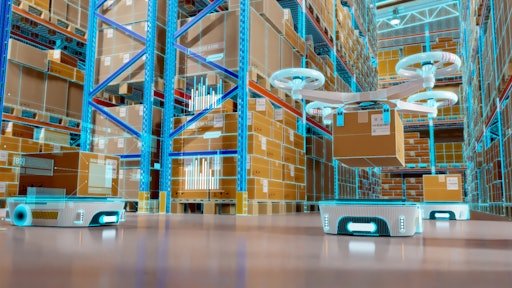Technology improvements are causing big changes in warehousing. The following are some important robots, AI, including smart inventory management trends in warehousing to keep an eye on:
Automation And Robotics:
- Robotic Material Handling:
In warehouses, robots are increasingly used to select, pack, and classify items and freight. Cobots, or collaborative robots, are gaining popularity because they may boost productivity by collaborating with humans. These cobots are made to operate alongside people, aiding them in activities that call for skill or accuracy. They free up human attention for more difficult and cognitive tasks by carrying large objects, moving through tight locations, and accurately performing repeated tasks.
- Self-Driving Mobile Robots (Amrs):
AI algorithms and sensors on AMRs allow them to navigate warehouses automatically. They are used to do things like deliver materials, which eliminates the need for manual labour. Automation boosts productivity while lowering the possibility of errors made by humans in warehouse operations. The supply chain management of warehouses can be even more productive overall because AI algorithms can analyse sensor data to optimise routes and make in-the-moment modifications.
- Drones Technology:
Drones are utilised for aerial inventory management and swiftly and accurately checking inventory in sizable facilities. These uncrewed aerial vehicles can efficiently navigate large warehouses, gathering information on stock levels and spot inconsistencies. Drones’ cutting-edge technology can considerably cut the time and labour needed for inventory management operations, increasing operational effectiveness overall.
Intelligent Computer Systems (AI):
- Predictive Analytics:
Using predictive analytics, warehouses may optimise inventory levels and cut expenses associated with carrying inventory. AI is used for forecasting demand trends. By using predictive analytics to examine past data and market patterns, warehouses can precisely predict client demand. As a result, there is less chance of understocking or overstocking because they may alter inventory levels properly. AI-driven forecasting models may deliver up-to-the-minute information on shifting customer preferences and market dynamics, empowering warehouses to make strategic decisions regarding inventory management and cut costs.
- Quality Control:
Based on artificial intelligence, vision systems are utilised for quality control assessments of incoming and outgoing commodities, lowering errors and raising the final output’s calibre. These vision systems use advanced algorithms to analyse visual data and find product flaws or irregularities. By automating the quality control process, businesses can conserve time and costs while maintaining consistent and superior products.
- Predictive Maintenance:
AI can identify when warehouse machinery and equipment need to be maintained or replaced, which lowers downtime and boosts operational effectiveness. AI can reliably forecast possible faults or issues regarding warehouse gear and equipment by analysing data and tracking performance. This preventative strategy enables prompt repair or replacement, preventing unanticipated breakdowns and improving warehouse productivity.
Intelligent Inventory Management
- IoT Integration: Real-time inventory tracking and Monitoring uses Internet-connected Things (IoT) devices. Stock level and condition data are provided via sensors on shelves and goods.
- Blockchain For Transparency: Supply chain tracking is transparent and secure. It enhances traceability and aids in the prevention of fraud and counterfeiting.
- Warehouse Management Systems: Advanced warehouse administration systems (WMS) with machine learning and artificial intelligence (AI) features are used to improve order picking, routing, and inventory placement.
Analytics Of Data
- The Gathering Of Big Data And Information Warehousing: Huge volumes of data are being gathered in warehouses. When making decisions, cutting costs in the supply chain, and optimising storage spaces. For inventory turnover and other areas, advanced data analytics solutions can help.
- Instantaneous Monitoring: instantaneous data analysis enables prompt reaction to shifting warehouse conditions, such as peaks in demand or equipment breakdowns.
Efficiency In Energy:
- Green Warehousing: Energy-saving heating, lighting, and cooling systems, as well as other sustainable practices, are becoming standard features in contemporary warehouses. Based on current facts, AI can optimise energy use.
Optimising Last-Mile Delivery:
Warehouses are focused on effective last-mile delivery to accommodate e-commerce needs. Algorithms for route optimisation enabled by AI speed up deliveries and save expenses. Thanks to AI-powered inventory management solutions, warehouses can maintain precise stock levels while lowering the danger of overstocking and running out of popular items. Automated packaging and sorting technologies accelerate and more effectively handle online orders during order fulfilment.
Intelligent Warehousing:
Warehouses have become more adaptable and versatile to cope with demand swings, seasonal shifts, and unforeseen catastrophes like the COVID-19 epidemic. This flexibility is greatly aided by decision-making that is AI-driven and scalable.
Security And Safety:
Security systems with artificial intelligence (AI) check warehouse properties for possible hazards or accidents, improving overall safety. These systems constantly learn and adjust to new threats by utilising machine learning algorithms, offering a proactive approach to security. They are more successful at seeing and reducing possible threats thanks to their ability to interface with current surveillance equipment and IoT devices.
Cooperative Human-Machine Systems:
Technology integration is enhancing rather than replacing human labourers’ abilities. Every shipping company Dubai requires employees to be trained and upskilled to work alongside machines. The need for humans to work together with automation to maximise efficiency and productivity drives this change in the worker dynamic. Employees can adapt to the changing demands of the marketplace and become useful assets in the day and age of automation by picking up new skills and expertise.
Regulatory Conformity:
To maintain conformity to safety, environmental, and information protection standards, warehouses increasingly embrace AI and data analytics.
Implementing robotics, artificial intelligence, and intelligent inventory management is crucial for keeping competitive and effective in the contemporary corporate landscape, and these trends indicate the ongoing evolution of the warehousing industry.


